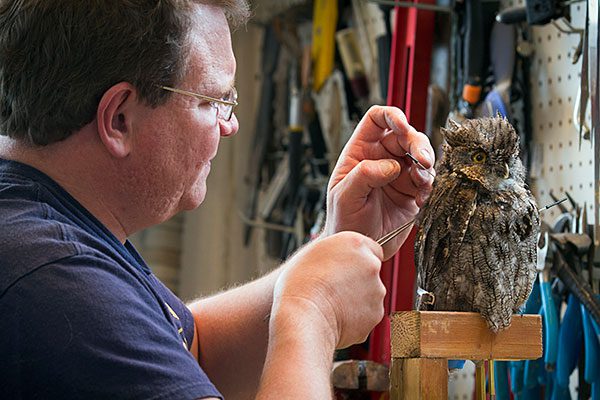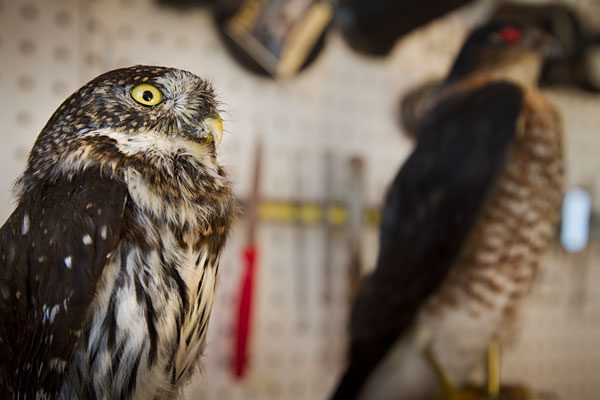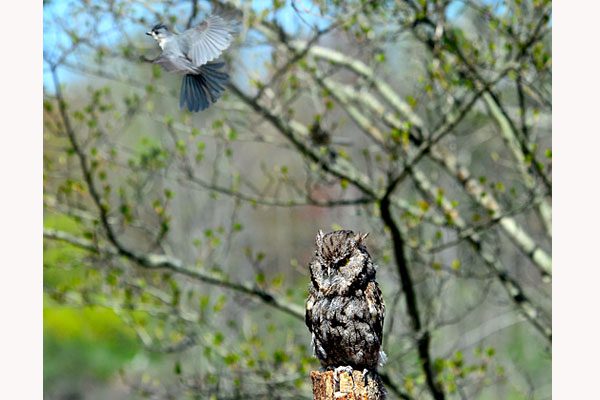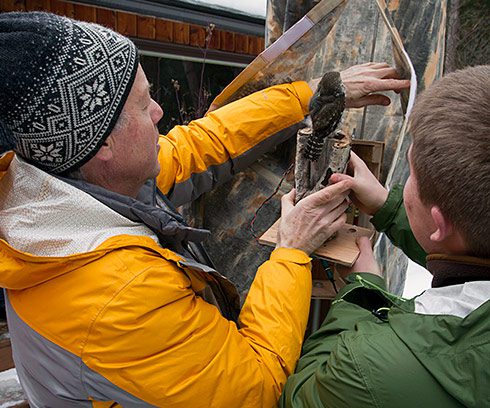Look out! The Backyard Bird Alarm Call Network
By Gustave Axelson
From the Winter 2016 issue of Living Bird magazine.
Black-capped Chickadee by Steve Gettle/Minden Pictures. January 26, 2016The woods are wiretapped. Everywhere eyes are watching. And the moment a Black-capped Chickadee sees something to be concerned about—say the slim silhouette of a Sharp-shinned Hawk perched in a tree—a rapid-response network kicks into action.
Chick-a-dee-dee-dee! The alarm call ricochets from chickadees to nuthatches to titmice to jays, and soon an angry horde of songbirds arrives to mob the intruder. Even after the sharpie gives up and flies off, the alarm call network keeps buzzing with a wave of real-time reports that the threat is now on the move. This new information can travel at speeds exceeding 100 miles per hour, giving birds advance warning to take cover.
After 10 years of studying alarm calls, University of Montana researcher Erick Greene says it’s a wonder predators ever beat the system.
“It’s really hard to be a hawk,” Greene says. “You’re hunting and flying around, trying to find your dinner, and yet there’s this bow wave of information that travels out in front of you faster than you can ever fly.”
Greene was part of a team that made newspaper headlines in 2005 with a paper in the journal Science that decoded the chick-a-dee alarm call of Black-capped Chickadees. They found that the number of -dees in a call correlated with the threat posed by a predator. More -dees mean a higher threat. So a Northern Pygmy-Owl (which specializes in hunting small birds) elicited a string of –dees from chickadees, sometimes as many as 12.
Now Greene is teaming up with Chris Clark of the Cornell Lab of Ornithology’s Bioacoustics Research Program and Mike Webster of the Macaulay Library on a National Science Foundation-funded project to delve even deeper into the complex communications that are alarm calls. Greene and his team are finding that different alarm calls can have specific meanings—that alarm calls are actually a spoken language among birds, and several species understand what’s being said.
In some experiments, Greene and his team play audio recordings of different species’ alarm calls near bird feeders and observe how the birds react. In others, the researchers employ roboraptors—taxidermied hawks and owls with robotic moving parts. On a sunny spring day last May at the Cornell Lab’s Sapsucker Woods headquarters in Upstate New York, Greene pressed the button on a modified garage door opener to drop a cloth curtain and reveal an animatronic Eastern Screech-Owl. Left to right, the roboraptor slowly swiveled its head (not unlike the mechanical children at Disney World who sing “It’s a Small World”). A pair of Tufted Titmice descended down the boughs of a nearby tree immediately, scolding all the way. Chickadees soon joined the protest to take turns dive-bombing the owl until the curtain went back up and the show was over. All the while, an array of microphones hidden in the underbrush captured every uttered sound, adding to Greene’s storehouse of alarm-call data.

Taxidermist Eugene Streekstra works on building a robo-raptor in his workshop near Missoula, Montana. Here he puts the finishing touches on a robo-screech-owl. Photo by Jeremy Roberts, Conservation Media. 
Of Greene's seven roboraptors, the smallest ones elicit the most fervent alarm responses from chickadees, such as his robo-Northern Pygmy-Owl. Photo by Jeremy Roberts, Conservation Media.

Eric Greene holds a robo-Northern Pygmy-Owl. The roboraptors are hidden behind a camouflage cloth until it’s showtime and the cloth drops to reveal the threat. Photo by Jeremy Roberts, Conservation Media. 
At an experiment conducted in Ithaca, New York, a Tufted Titmouse was the first to spot and sound the alarm about the appearance of an Eastern Screech-Owl roboraptor. Photo by Tim Gallagher.
Back on his home turf near Missoula, Montana, Greene and his team are analyzing the spectrograms of thousands of alarm calls in audio labs. When Greene and graduate student Alexis Billings took a closer look at the harsh, guttural wah-wah-wah mobbing calls of Steller’s Jays—meant to intimidate a robotic Northern Goshawk—they noticed that these were loud, harsh, large-bandwidth sounds. In other words, sounds designed to travel far and wide and be very easy to locate. Greene says these kinds of calls are given for a stationary threat, such as a perched raptor.

“The intent here is to call in the troops,” Greene says. “It may seem counterintuitive for birds to mobilize and fly toward a threat, but a perched raptor is not as dangerous as a flying, actively hunting raptor. The idea is to gather as many jays as possible and make a bunch of loud, raucous calls to let this hawk know its cover is blown and it has little chance of hunting successfully, so it might as well move on.”
On the other hand, Greene has recorded alarm calls that sound like seet-seet-seet and have a different meaning. Seets are high-pitched calls given when a raptor is in flight. For the raptor, it’s hard to tell where these sounds are coming from. But small birds hear it and know immediately what to do—duck into cover or freeze. In one experiment in Montana, a peripatetic Red-breasted Nuthatch was observed bouncing around feeder to feeder, but then Greene broadcast a snippet of seet calls lasting a single second. Instantly the nuthatch froze in place, seed in its bill, and stayed that way—an ornamental bird statue—for half an hour.
“Alarm calls evoke a powerful response,” Greene says. “For birds, it’s life or death.”
Because seet calls are higher frequency than mobbing calls, they don’t transmit as far. And yet, the message still moves quickly throughout the woods, thanks to a rapid-relay system. Think of the old-time bucket brigades used to put out a fire. In experiments using extensive networks of microphones placed every 50 meters—covering the acoustic landscape, as Greene says—he has recorded seet calls relayed across several different species, from Black-capped Chickadees to Lazuli Buntings to House Finches to Song Sparrows. The microphone array clocked the alarm signal traveling up to 100 mph from an initial point to 200 meters away (about the length of two football fields).
More than 50 different species are known to respond to a chickadee’s mobbing calls. Alarm calls can be understood easily by different species because, even though each species has its own call, the acoustic properties are similar. All mobbing calls are large bandwidth. (Birders, you’re actually mimicking a mobbing call every time you engage in pishing, which is a large-bandwidth sound.)
All seet calls are in the same frequency range. Other research has shown that Australian fairywrens will flee in response to the seet calls of species they’ve never heard before. Greene has documented that even red squirrels and chipmunks can understand the meaning of seet calls, and vice versa—the alarm squeaks of red squirrels elicit a take-cover response among chickadees.
“It’s the universal language of ‘look out!’” says Janelle Morano, a Cornell Lab researcher who’s coordinating the experiments in Ithaca, New York. Morano says she was amazed the first time she lowered the curtain to reveal a robotic owl at a backyard bird feeder.
“Everybody stopped feeding. Then the chickadees and titmice went crazy. Then before you know it, there’s Blue Jays squawking, squirrels screeching, it’s a madhouse.”
She was doubly amazed when she got back into the Macaulay Library studio and downloaded the recordings for analysis. The chorus of alarm calls had ballooned from a few birds to more than 20 individuals. In just 5 minutes, she had recorded more than 800 chickadee call notes alone.
“There’s so much data to be analyzed every time an alarm call goes out,” she says.

All About Birds
is a free resource
Available for everyone,
funded by donors like you
American Kestrel by Blair Dudeck / Macaulay Library








